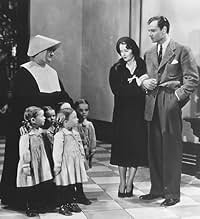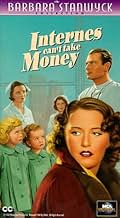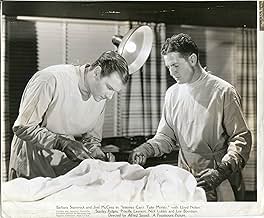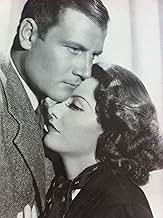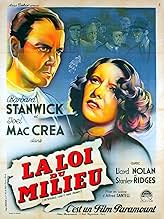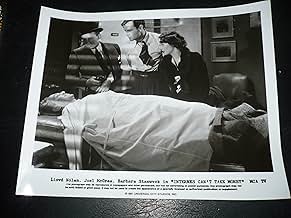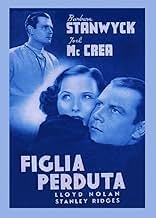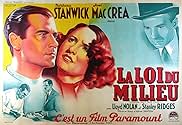अपनी भाषा में प्लॉट जोड़ेंIn his first film, young Dr. Kildare helps a female ex-con find her child.In his first film, young Dr. Kildare helps a female ex-con find her child.In his first film, young Dr. Kildare helps a female ex-con find her child.
- निर्देशक
- लेखक
- स्टार
- पुरस्कार
- कुल 1 जीत
Steve Pendleton
- Interne Jones
- (as Gaylord Pendleton)
James Adamson
- Porter
- (बिना क्रेडिट के)
Agostino Borgato
- Popcorn Vendor
- (बिना क्रेडिट के)
Helen Brown
- Nurse
- (बिना क्रेडिट के)
फ़ीचर्ड समीक्षाएं
A wildly improbable drama, the misspelled "Internes Can't Take Money" was the first in the "Dr.Kildare" movie series, which was subsequently recast with Lew Ayres in the title role and continued at the MGM studio, following this initial Paramount effort. Concocted by writer Max Brand, the story involves an honest young intern at a large hospital, who crosses paths with a widowed ex-con seeking to locate her three-year-old daughter, who was abducted by her deceased bank-robber husband. The recipe is an old one; toss in a couple of shady characters and a gangster with a heart of gold, who is embroiled in illegal betting, add a tolerant landlady and a kindly bartender, sprinkle with nuns, mix with unexpected twists, and bake until overdone.
Despite an uninspired title and a routine script, director Alfred Santell maintains a steady pace that will distract viewers from the at-times laughable plot turns that lead to a teary fade-out, provoked either by laughter or sentiment. Beyond the script, the film's technical aspects are quite good, especially the black and white cinematography by Theodor Sparkuhl, who often dramatically captures Stanwyck garbed in deep black, contrasting with McCrea, dressed in his intern's whites.
Barbara Stanwyck plays the widow, Janet Haley, and the actress, at her sudsy distraught-mother best, is convincing in an unconvincing role. Joel McCrea is the original Dr. Kildare, a straight-arrow intern, poorly paid and burdened by work and rules, who seeks solace at a nearby bar, where his life takes a sudden turn. Stanwyck and McCrea, in their third co-starring film, work well together, and Stanwyck seems genuinely taken with McCrea during their first scene together. Attesting to what makes a film star a star, Stanwyck and McCrea add dimension and interest to otherwise cardboard characters in credibility-stretching situations. In addition to the two stars, the capable cast also includes Lloyd Nolan, Stanley Ridges, and Charles Lane. However, if not for the professionalism and charisma of the leads and supporting players, "Internes Can't Take Money" would be 80 minutes of laughable coincidences and plot turns, memorable only as the first in the Dr. Kildare movie series.
Despite an uninspired title and a routine script, director Alfred Santell maintains a steady pace that will distract viewers from the at-times laughable plot turns that lead to a teary fade-out, provoked either by laughter or sentiment. Beyond the script, the film's technical aspects are quite good, especially the black and white cinematography by Theodor Sparkuhl, who often dramatically captures Stanwyck garbed in deep black, contrasting with McCrea, dressed in his intern's whites.
Barbara Stanwyck plays the widow, Janet Haley, and the actress, at her sudsy distraught-mother best, is convincing in an unconvincing role. Joel McCrea is the original Dr. Kildare, a straight-arrow intern, poorly paid and burdened by work and rules, who seeks solace at a nearby bar, where his life takes a sudden turn. Stanwyck and McCrea, in their third co-starring film, work well together, and Stanwyck seems genuinely taken with McCrea during their first scene together. Attesting to what makes a film star a star, Stanwyck and McCrea add dimension and interest to otherwise cardboard characters in credibility-stretching situations. In addition to the two stars, the capable cast also includes Lloyd Nolan, Stanley Ridges, and Charles Lane. However, if not for the professionalism and charisma of the leads and supporting players, "Internes Can't Take Money" would be 80 minutes of laughable coincidences and plot turns, memorable only as the first in the Dr. Kildare movie series.
The first Dr. Kildare film, from Paramount. It has no connection to the later MGM series, of which I'm a big fan. Despite not having many of the elements I enjoy in those movies, this one is still entertaining. Joel McCrea and Barbra Stanwyck have nice chemistry. Lloyd Nolan and Stanley Ridges are great as gangsters, one rotten and one not so much. The best parts of the film are the hospital scenes that give us lots of "window into the past" bits that show us how life was at the time. Particularly how the medical profession was different. The visual style is more enhanced in these scenes, too. The hospital set is also pretty cool. Probably the one thing this film has over the MGM series. Worth a look whether you are a fan of Kildare or not.
Probably not, but it has a certain cachet to it that is reminiscent of the genre that was yet to come. Good folk and gangsters, an unsuspecting someone caught in a web of dishonesty and murder, and all with the shadows and photographic effects normally associated with film noir. It is also an early Dr. Kildare film with Joel McCrea as the good doctor.
Nutshell: Kildare comes across Barbara Stanwyck, who is destitute and desperate. She is looking for her lost child and she is broke and just released from prison, apparently framed for aiding and abetting her husband. Kildare tries to help, with the aid of a gangster (Lloyd Nolan) on whom he has done emergency surgery (in the back of a barroom!) and who now feels he owes Kildare a favor.
The cast is excellent, headed by Stanwyck who never gives a bad performance. McCrea is his usual understated self and Stanley Ridges is very effective as a seedy, slimy villain. This is a very underrated film and was shown at Capitolfest, Rome, NY, 8/19.
******** 8/10 - Website no longer prints my star rating.
Nutshell: Kildare comes across Barbara Stanwyck, who is destitute and desperate. She is looking for her lost child and she is broke and just released from prison, apparently framed for aiding and abetting her husband. Kildare tries to help, with the aid of a gangster (Lloyd Nolan) on whom he has done emergency surgery (in the back of a barroom!) and who now feels he owes Kildare a favor.
The cast is excellent, headed by Stanwyck who never gives a bad performance. McCrea is his usual understated self and Stanley Ridges is very effective as a seedy, slimy villain. This is a very underrated film and was shown at Capitolfest, Rome, NY, 8/19.
******** 8/10 - Website no longer prints my star rating.
The acting and plot were strong here, and a very enjoyable movie. There is great chemistry with Joel McCrea and Barbara Stanwyck. Stanwyck per norm does great, dramatic work here.
The show stealer is Stanley Ridges. His creep who will help Stanwyck find her child -- only if she sleeps with him long-term and becomes his moll -- is chilling. It's one of the best performances I've ever see of a subtle, sinister gangster who alludes to dastardly deeds, without ever directly saying it. He doesn't ask her to sleep with him, he just munches popcorn, and offers her some. When she declines he says "At some point you should like popcorn." He is direct, firm and sleezy in a must-see performance.
The other scene stealer is Lloyd Nolan. A phenomenal what you would typically like a from a gangster, but with more depth. Great pauses, thoughtfulness and facial expressions in his conversations with McCrea. He's your ideal tough gangster but also has a bit of compassion. Just a bit.
MCrea is always a joy to watch - stable, sure performance.
Internes Can't Take Money is a clear title about the dilemma, and points to the moral quandary to come. But a more compelling title can be found, which that alone, would have made this a more sophisticated movie and higher up in the ranks.
The show stealer is Stanley Ridges. His creep who will help Stanwyck find her child -- only if she sleeps with him long-term and becomes his moll -- is chilling. It's one of the best performances I've ever see of a subtle, sinister gangster who alludes to dastardly deeds, without ever directly saying it. He doesn't ask her to sleep with him, he just munches popcorn, and offers her some. When she declines he says "At some point you should like popcorn." He is direct, firm and sleezy in a must-see performance.
The other scene stealer is Lloyd Nolan. A phenomenal what you would typically like a from a gangster, but with more depth. Great pauses, thoughtfulness and facial expressions in his conversations with McCrea. He's your ideal tough gangster but also has a bit of compassion. Just a bit.
MCrea is always a joy to watch - stable, sure performance.
Internes Can't Take Money is a clear title about the dilemma, and points to the moral quandary to come. But a more compelling title can be found, which that alone, would have made this a more sophisticated movie and higher up in the ranks.
An exceptionally flavorful rendering of the Depression atmosphere: a world of the poor laboring in sweatshop jobs, petty hoods hanging out in smoky bars, backroom bookie joints, pushcart vendors and bus terminals and orphanages. While the plot is no more ambitious than the typical B movie of the time, the high production values, name cast, and imaginative direction from Alfred Santell all boost the quality.
At the center of the plot, Barbara Stanwyck spends much of the film in desperation mode, exhausted from searching for her lost child, beaten down by two years in jail, forced to hire stool pigeons, forced to stay alert.
Joel McCrea makes the ideal American hero for the 30's: not only a doctor, but tall, blond, honest, sincere, manly, and progressive. At one point, he has to perform an operation on a bar room table, improvising with violin strings, an ice pick, and a bottle of rum! But this is not MGM's Dr. Kildare. He has no warm relationship with a kindly old mentor; instead, the chief doctor is an authority figure upholding the rules, dismissing Lee Bowman for unauthorized experimentation. The script also pumps up sympathy for interns as underpaid workers who get only $10 a month.
As a gangster, the always fascinating Stanley Ridges conveys the calm of a man secure in his power, whose eye movements size up his adversaries and whose silences reveal more menace than mere words. Watch the sexual innuendo he finds in his "I didn't always like popcorn" speech.
Santell uses extreme close-ups and moves the camera often, aided by gleaming lighting from Theodore Sparkuhl, plus some knock-out sets, including a sparkling white Art Deco clinic and an elaborately detailed New York Irish bar. Watch how economically Santell works to show the awakening of mutual attraction between Stanwyck and McCrea in their first scene together. Also lifting the picture out of its formula origins is the headlong pace Santell maintains to the climax, an urgency lost in the blander MGM series.
At the center of the plot, Barbara Stanwyck spends much of the film in desperation mode, exhausted from searching for her lost child, beaten down by two years in jail, forced to hire stool pigeons, forced to stay alert.
Joel McCrea makes the ideal American hero for the 30's: not only a doctor, but tall, blond, honest, sincere, manly, and progressive. At one point, he has to perform an operation on a bar room table, improvising with violin strings, an ice pick, and a bottle of rum! But this is not MGM's Dr. Kildare. He has no warm relationship with a kindly old mentor; instead, the chief doctor is an authority figure upholding the rules, dismissing Lee Bowman for unauthorized experimentation. The script also pumps up sympathy for interns as underpaid workers who get only $10 a month.
As a gangster, the always fascinating Stanley Ridges conveys the calm of a man secure in his power, whose eye movements size up his adversaries and whose silences reveal more menace than mere words. Watch the sexual innuendo he finds in his "I didn't always like popcorn" speech.
Santell uses extreme close-ups and moves the camera often, aided by gleaming lighting from Theodore Sparkuhl, plus some knock-out sets, including a sparkling white Art Deco clinic and an elaborately detailed New York Irish bar. Watch how economically Santell works to show the awakening of mutual attraction between Stanwyck and McCrea in their first scene together. Also lifting the picture out of its formula origins is the headlong pace Santell maintains to the climax, an urgency lost in the blander MGM series.
क्या आपको पता है
- ट्रिवियाBarbara Stanwyck asked director Al Santell to cast Joel McCrea as her leading man, having worked with him twice before. "I want this guy," she told him. "He's going to be a good leading man."
- गूफ़During the bar-room conversation (c.16 minutes) the coffee cup on the table disappears, re-appears and moves between shots.
- भाव
Bookie: Maybe it's the cops.
"Chief" Hanlon: Cops don't knock, they break in.
- कनेक्शनFollowed by Young Dr. Kildare (1938)
टॉप पसंद
रेटिंग देने के लिए साइन-इन करें और वैयक्तिकृत सुझावों के लिए वॉचलिस्ट करें
- How long is Internes Can't Take Money?Alexa द्वारा संचालित
विवरण
- रिलीज़ की तारीख़
- कंट्री ऑफ़ ओरिजिन
- भाषा
- इस रूप में भी जाना जाता है
- Unga läkare
- फ़िल्माने की जगहें
- मैनहटन, न्यूयॉर्क शहर, न्यूयॉर्क, संयुक्त राज्य अमेरिका(Second unit opening credits)
- उत्पादन कंपनी
- IMDbPro पर और कंपनी क्रेडिट देखें
- चलने की अवधि
- 1 घं 18 मि(78 min)
- रंग
- पक्ष अनुपात
- 1.37 : 1
इस पेज में योगदान दें
किसी बदलाव का सुझाव दें या अनुपलब्ध कॉन्टेंट जोड़ें

